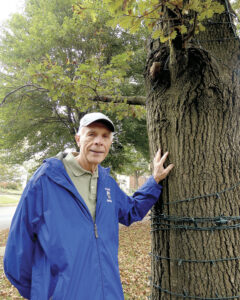Hungarian roots run deep in Poland Village

Staff photo / Lily Nickel.... Dave Smith, member of the Hine Memorial Board and Poland Historical Society, stands under the Hungarian oak tree on the Village Green.
POLAND — An unusual tree sits on the Village Green here, disguising itself as one of the many native trees that surround it — despite its mysterious, foreign roots.
A Hungarian oak, native to southeastern Europe and Turkey, sits just off South Main Street.
It’s in an area in Poland that is rich with history dating back to the late 1700s, when American pride was at an all-time high after the American Revolution. Despite its deceivingly European name, Poland prides itself on its all-American aesthetic and persona, so the mystery of how a Hungarian tree was planted in such a place may leave locals scratching their heads.
The true identity of the tree did not come to light until Dave Smith, a member of the Hine Memorial Board that oversees the Village Green, had the idea to do a survey on tree identification of the area.
But he needed help.
“I wanted to get every tree identified and marked for what kind of tree it is,” Smith said during an October presentation to village council. “And that’s not a job I can do — I just learned the difference between a sugar maple and a Christmas tree.”
He reached out to Ken Filicky, Poland Township Park Board chairman, who brought in his son, Kyle, a professional wetland scientist and project manager at Civil & Environmental Consultants Inc. in Pittsburgh. The pair used a handheld GPS that picks up images from up to 30 satellites to get an overview of the area and create a map. They went to each tree individually and examined leaves, bark and seeds to identify it.
They ended up identifying 86 trees — with one that stood out to Kyle.
HOW IN THE WORLD?
“The most interesting one we observed was a Hungarian oak, and we don’t know how it got there,” Kyle said.
While the type of tree itself is interesting, its appearance also is odd compared with native trees. The waxy and nearly perfect round lobed leaves throughout the tree are clearly not like its neighbor’s, the black oak. Because the species is native to mountainous regions, it can grow to be more than 100 feet tall, but for now its height remains modest.
Kyle estimates the tree to be between 50 and 60 years old, meaning it was planted in Poland soil up to 30 years before the tree was introduced to the United States, according to Urban Forest Nursery Inc.
“It’s neat to wonder who put that there and why. The only other Hungarian oak that I know of in Mahoning County is at the Mill Creek Rose Garden,” Kyle said.
Based on the visual size of both trees, he estimated them to be around the same age.
Both trees had to be purchased intentionally from a local or regional tree nursery, but Hungarian oak saplings are hard to come by even today, he said.
BEST GUESS
Kyle’s best guess is that the trees were planted by the same person or environmental group. The tree isn’t native to the U.S., let alone the state, so the tree had to be planted intentionally rather than accidentally by a squirrel that forgot where it buried an acorn.
Hungarian oaks are ornamental trees that are often used for wine barrels in Hungary. The trees grow in two main forests in Hungary; the Mecsek and Zemplin. The volcanic soil in that region is prime for growing these trees, according to the Hungarian Academy of Science, which leaves one to wonder why someone would choose to plant one in the glacial till of Ohio.
Smith, a member of the Poland Historical Society, can rattle off the history of every brick-and-mortar structure along South Main Street. He can tell you the history of every family that has lived in the houses that are a stone’s throw away from the tree.
But that mysterious oak even stumps him.
According to Smith, there’s no record of how the tree got there, despite it being planted among trees that had to be approved by the village administration before being planted.
The true origin of the tree may never be unveiled, but theories of how and why it came to be will keep Poland entertained as the tree grows deeper into the village’s land and history.
lnickel@tribtoday.com





